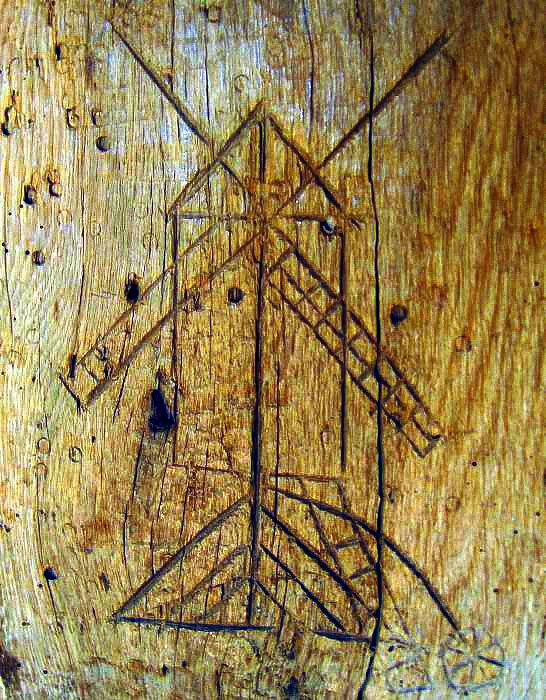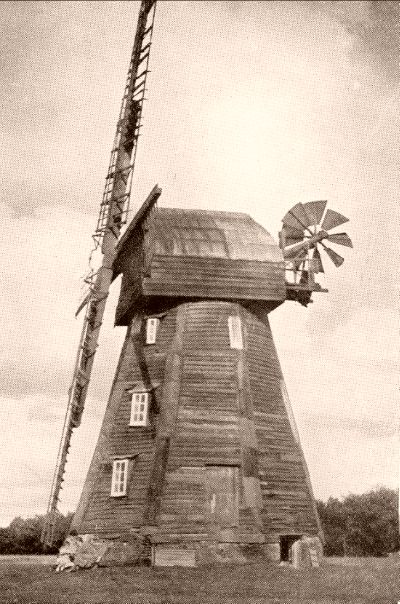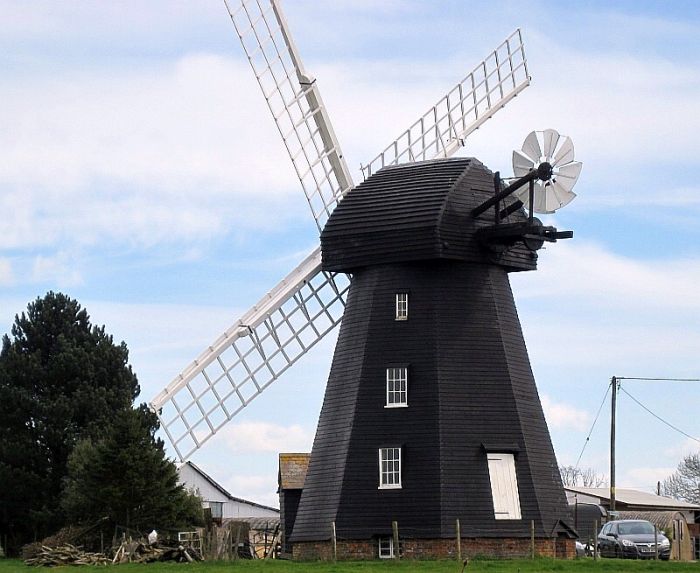|
. . . . AND THOSE AROUND TRING
CHAPTER XIII.
LACEY
GREEN SMOCK MILL
“Loosley Row, situated on the Chiltern
Hills, in the southern part of this parish, is on the side of a
lofty eminence, on the summit of which is a windmill, whence is an extensive
and beautiful panoramic view, including/ Windsor castle and the
Surrey Hills on the south . . . .”
The History and Antiquities of the
County of Buckingham,
George Lipscomb (1847)
.jpg)
Fig. 13.1: Lacey Green (Loosley
Row) smock
mill
Smock mills were most prevalent
in the south-east, particularly in Kent, where ‘Union
Mill’ at Cranbrook has the distinction of being the tallest in the U.K. Although there were other
examples of smock mills in Herts and Bucks, only three are recorded in this
area; those at Hawridge and Wingrave are long gone, but an example
survives at Lacey Green near Princes Risborough, which has the distinction of being the
oldest of its type in the country. [21]
Originally referred to as Loosley Row windmill, the adjacent hamlet
of that name was later absorbed into the expanding village of Lacey
Green. The mill is an exceptionally early example of its
type, being contemporary with the post mills at Pitstone and Brill:
“This is an octagonal mill with a brick
basement and a timber body . . . .
Even before the actual date of Looseley Row Mill (or Lacey Green
Mill as it is now called) was authenticated, the mill was recognised
from its primitive equipment to be of an exceptionally early date,
and there can be no doubt that the massive compass arm brake wheel
and other gear are part of the original machinery with which she was
equipped in 1650. The very existence of smock mills at so
early a date was not previously established, but the deeds leave no
room for doubt in the matter; and they provide us incidentally with
the knowledge that the mill was removed from Chesham, by order of
the Duke of Buckingham in the year 1821 . . . . The numbered timbers
on the tower indicate that it was dismantled for removal and
reassembled. ”
Unpublished manuscript by Stanley Freece (1939),
the Centre for Buckinghamshire Studies.

Fig. 31.2: millwright’s
graffiti?
A somewhat odd feature that immediately strikes visitors, is that
entry to the mill is through a basement — in fig. 13.1, the doorway
is on the right of the mill beneath the white sign. The mill’s
brickwork foundation stands about 2½ feet above the ground, but the
floor within is sunk, the basement being entered down a small flight
of steps. Another interesting feature is the carvings in the
windmill woodwork, presumably made by millwrights who at some time
in the distant past worked on the mill. Curiously, that
depicted in fig. 13.2 is an open trestle post mill rather than a
smock mill. |
.JPG)
|
Fig. 13.3: Lacey Green
mill looking up into the cap. On the left is the brake wheel,
at the top the windshaft, and above to the right, the wallower.
The machinery at Lacey Green is wooden, unlike the later mill at
Quainton, iron being restricted to a reinforcing role.
The mill predated the invention of the fantail,
[22] cap originally
being turned to wind by hand using an endless
chain. The existing fantail is a later addition. |
|
“The mechanism has indications of
being rather greater antiquity than is usual in a smock mill.
Both the brake wheel and the great spur wheel are of a type that
must have been becoming obsolete in the seventeenth century.
The brake wheel is large, 9 feet 8 inches in diameter, and this, the
great spur wheel and the wallower are entirely of wood, the spokes
of oak, the rims of elm, the cogs and teeth of beech. Both
wind shaft and the main shaft are of wood, the former being 20
inches in diameter at the brake wheel and the latter — an octagonal
shaft — being 14 inches across the flats.”
English Windmills, Vol. 2, by
Donald Smith (1932) |
.JPG) |
.JPG) |
|
Fig. 13.4: top left is a
‘stone
nut’
driven by the
‘great
spur wheel’
(right). The chute
in the foreground
delivers grain to the hopper beneath, from where it is trickled
into the eye
of the millstones for grinding. See figs
3.8 &
3.9. |
Fig. 13.5: another view of the
mill’s
‘overdriven’
(from above) stones.
Top left is the great spur wheel engaging
with a wooden stone nut.
The metal shaft
drives the runner stone. |
.JPG)
|
Fig. 13.6: looking up into the cap at two of the
centring wheels. Fairly closely spaced roller wheels carry the
cap upon the iron curb, whilst two large eight-spoked centring
wheels are attached to the tail-part of the cap-frame; two others
are at the ends of the sprattle beam and two in between on
projecting spars. |
|
 |
.JPG) |
|
Fig. 13.7: the basement of the
mill (the meal floor) showing
the miller’s
desk and the meal bin. |
Fig. 13.8: the
‘upright
(or main) shaft’
above which is the great spur wheel.
The upright shaft revolves in a thrust bearing
fixed to the sprattle beam (the large beam immediately
above). |
|
 |
|
Fig. 13.9: in
glory days — two patent and two simple sails. |
|
 |
|
Fig. 13.10: Lacey
Green mill, pre-1932. |
In 1895, the mill was badly damaged in a thunderstorm and, at a time when windmilling was in decline, it’s no small wonder that
it survived such a setback:
|
“THUNDERSTORM.
— The storm of the 30th ult. was very severe here, and
did considerable damage to the windmill belonging to Mr.
Geo. Cheshire. The lightning struck the mill,
taking off several boards from the upper part and
tearing up the leaden plates which cover the angle
joints of the boarding all down one side. One of
the sails was destroyed; the chief timber, 10 inches by
10, was split from end to end, about eight feet of it
being splintered to atoms, and scattered far and wide
all round the mill, some of the pieces being picked up
over a quarter of a mile away. The supporting
beam, seven inches square, was also split throughout its
entire length. The copsing iron around the end of
the sail ⅝ inch by 1¼, was cut in half and hurled over a
hundred yards away. The woodwork was blackened,
and had it not been for the heavy rain the mill would no
doubt have been set on fire. The accident is all the
more unfortunate seeing that on March 24th all four
sails were blown down and destroyed by a gale, and Mr.
Cheshire had just had a new set made; in fact, two only
were in position, having been put up a few days before
the storm.”
The Bucks Herald,
8th August 1895. |
The
Cheshire family were the last millers, the windmill last being used for
milling in 1914-15. Following WWI., it was for a time used as
a week-end cottage, but by
1932 it was in a parlous state and in danger of collapse:
|
“The weather-boarding has been
covered with a patent roofing material. The
timbers in the tower are so eaten with woodworm and
attacked by rot that the mill is in imminent danger of
collapse. The cap was originally turned by hand by
use of an endless chain, but a fantail was added later.
This came down with the weight of snow on Boxing day
‘some winters ago.’ It had two common sails and two
patent sails and a fantail. The two common sails
have fallen off, as has the fantail also. The mill
is now leaning badly.”
English Windmills,
Vol. 2, by Donald Smith (1932). |
The Society for the Protection of Ancient Buildings organised the
repair and strengthening of the structure, which took place in
1934-5. This work included fitting extra corner posts
bolted to the old timbers and set in concrete foundation blocks,
refurbishment of the cap, and painting the exterior of the mill.
But without a constant programme of upkeep, a wooden structure of
this age inevitably decays, and by the 1960 the mill was again in a very
sorry condition:
|
 |
|
Fig. 13.11: an
artist’s
impression of the mill in 1967 |
“Now used as a store for straw
bales its condition is rapidly deteriorating. The tower has an
increasingly pronounced lean, which suggests that it may be unable
to withstand too strong a wind from any unfavourable quarter.
Any rodents attracted by the straw could be an additional hazard to
its structural integrity.”
Bucks Life, March 1967 |
A survey carried out by Christopher Wallis during
1967-68, established that restoring the mill was feasible. In
1971, the mill was leased by the Chiltern Society for a period of 25
years, and a team of volunteers began restoration, which continued
over the following 12 years. On 23rd April 1983, the mill was
opened at a ceremony conducted by the Actor Bernard Miles.
Since then, the mill has been placed in sail occasionally and flour
has been ground. |

Fig. 13.12: Lacey Green
windmill today, simple sails on all sweeps
――――♦――――
CHAPTER XIV.
|